STATUE DE BOUDDHA EN SCHISTEANCIENNE RÉGION DU GANDHARA, III/IVE SIÈCLE 147.5 cm (58 1/8 in.) high FootnotesA SCHIST FIGURE OF BUDDHA ANCIENT REGION OF GANDHARA, 3RD/4TH CENTURY 犍陀羅 三/四世紀 片岩佛陀像 Published: Mario Bussagli, L'Arte del Gandhara, Torino, 1984, p. 100, no. 3. Provenance: With Claude de Marteau, Brussels, by 1970s Supporting numerous publications on the art of ancient Gandhara, Claude de Marteau was perhaps best known for his expertise in Gandharan sculpture. His connoisseurship is epitomized by this almost life-size statue of the Buddha, which excels for its naturalism, grace, and contemplative attitude. The ancient region of Gandhara, which spanned modern-day northwest Pakistan and southern Afghanistan, was home to a vibrant, cosmopolitan civilization situated at the crossroads of international trade networks linking South Asia, Central Asia, China, and the Mediterranean. Because of its verdant terrain and lucrative trade position, the region fell repeatedly to foreign raids and invaders. The Kushans, originally from Central Asia and already having incorporated elements of Greek culture, established themselves in Gandhara in the early first century CE. Under the Kushan ruler Kanishka (127-151 CE), Gandharan Buddhist art and architecture flourished, resulting in the creation of some of the earliest iconic images of the historical Buddha, such as the present statue. Indicative of Gandharan art's appealing multiculturalism, the stone carver who created the present image of the Buddha was clearly as well-versed in Buddhist iconography as he was in the Greco-Roman aesthetic tradition of naturalism. He succeeds in realistically modelling the figure's stance with a gentle, understated contrapposto, lightly bending the right knee and placing more weight on the left leg—imbuing movement within his creation. He effortlessly conveys the Buddha's supple physique, suggested under the sweeping pleats of his heavy monastic robe. To this, the sculptor has added certain physiological features, rooted in Indic religions, that distinguish an enlightened being (mahalakshana). A raised circular dot in the middle of his brow represents his urna, from which in many sutras, the Buddha emits a ray of light to illuminate distant worlds. Crisp, wavy locks are pulled over an ushnisha, a cranial protuberance endowed with a variety of magical powers. Another prominent symbol of his enlightened consciousness is the large halo backing his head and shoulders. But perhaps most profound is the arresting quietude evoked by his heart-shaped, mustachioed visage, whose heavy-lidded downward expression conveys a solemn detachment from the world. The present sculpture's torso and stance are portrayed with a higher degree of naturalism than a representative example in the British Museum (1947,0511.1). The soft treatment of the robes compares well with Gandharan sculptures of the Buddha held in the Norton Simon Museum, Pasadena (F.1975.04.2.S), and sold at Christie's, New York, 21 March 2008, lot 527. A Gandharan Buddha with a similar cordate facial type is in the Tokyo National Museum (C0097675). Depicting Maitreya, the Future Buddha, venerated in the pedestal below Shakyamuni's feet, the present sculpture belongs to an iconic trope in Gandharan art also represented by a Buddha in the Metropolitan Museum of Art, New York (2014.188), and reflected in examples sold at Christie's, New York, 25 March 2004, lot 18, and Bonhams, Hong Kong, 2 December 2021, lot 1036.
STATUE DE BOUDDHA EN SCHISTEANCIENNE RÉGION DU GANDHARA, III/IVE SIÈCLE 147.5 cm (58 1/8 in.) high FootnotesA SCHIST FIGURE OF BUDDHA ANCIENT REGION OF GANDHARA, 3RD/4TH CENTURY 犍陀羅 三/四世紀 片岩佛陀像 Published: Mario Bussagli, L'Arte del Gandhara, Torino, 1984, p. 100, no. 3. Provenance: With Claude de Marteau, Brussels, by 1970s Supporting numerous publications on the art of ancient Gandhara, Claude de Marteau was perhaps best known for his expertise in Gandharan sculpture. His connoisseurship is epitomized by this almost life-size statue of the Buddha, which excels for its naturalism, grace, and contemplative attitude. The ancient region of Gandhara, which spanned modern-day northwest Pakistan and southern Afghanistan, was home to a vibrant, cosmopolitan civilization situated at the crossroads of international trade networks linking South Asia, Central Asia, China, and the Mediterranean. Because of its verdant terrain and lucrative trade position, the region fell repeatedly to foreign raids and invaders. The Kushans, originally from Central Asia and already having incorporated elements of Greek culture, established themselves in Gandhara in the early first century CE. Under the Kushan ruler Kanishka (127-151 CE), Gandharan Buddhist art and architecture flourished, resulting in the creation of some of the earliest iconic images of the historical Buddha, such as the present statue. Indicative of Gandharan art's appealing multiculturalism, the stone carver who created the present image of the Buddha was clearly as well-versed in Buddhist iconography as he was in the Greco-Roman aesthetic tradition of naturalism. He succeeds in realistically modelling the figure's stance with a gentle, understated contrapposto, lightly bending the right knee and placing more weight on the left leg—imbuing movement within his creation. He effortlessly conveys the Buddha's supple physique, suggested under the sweeping pleats of his heavy monastic robe. To this, the sculptor has added certain physiological features, rooted in Indic religions, that distinguish an enlightened being (mahalakshana). A raised circular dot in the middle of his brow represents his urna, from which in many sutras, the Buddha emits a ray of light to illuminate distant worlds. Crisp, wavy locks are pulled over an ushnisha, a cranial protuberance endowed with a variety of magical powers. Another prominent symbol of his enlightened consciousness is the large halo backing his head and shoulders. But perhaps most profound is the arresting quietude evoked by his heart-shaped, mustachioed visage, whose heavy-lidded downward expression conveys a solemn detachment from the world. The present sculpture's torso and stance are portrayed with a higher degree of naturalism than a representative example in the British Museum (1947,0511.1). The soft treatment of the robes compares well with Gandharan sculptures of the Buddha held in the Norton Simon Museum, Pasadena (F.1975.04.2.S), and sold at Christie's, New York, 21 March 2008, lot 527. A Gandharan Buddha with a similar cordate facial type is in the Tokyo National Museum (C0097675). Depicting Maitreya, the Future Buddha, venerated in the pedestal below Shakyamuni's feet, the present sculpture belongs to an iconic trope in Gandharan art also represented by a Buddha in the Metropolitan Museum of Art, New York (2014.188), and reflected in examples sold at Christie's, New York, 25 March 2004, lot 18, and Bonhams, Hong Kong, 2 December 2021, lot 1036.
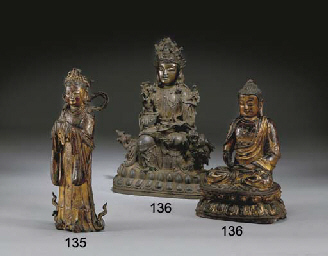
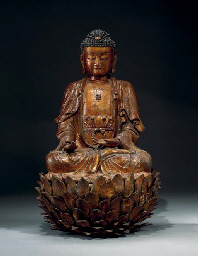
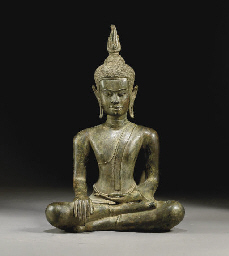
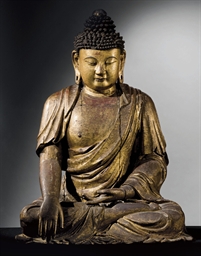
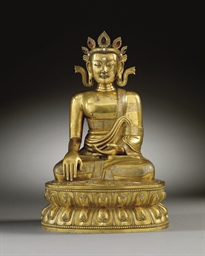
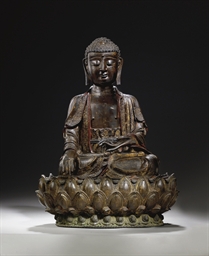
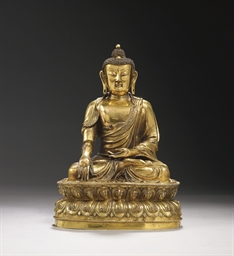
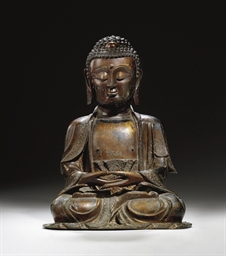
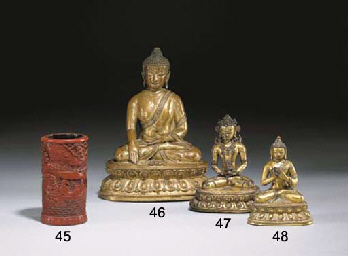
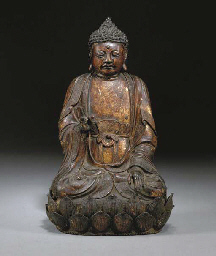
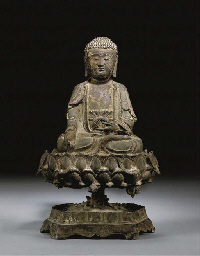
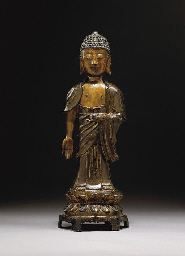
.jpg)
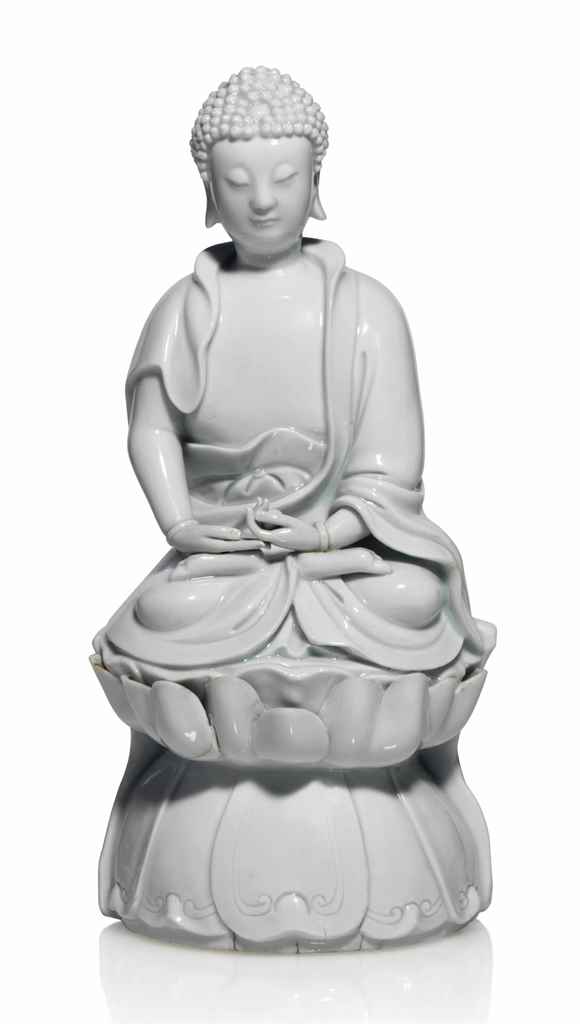
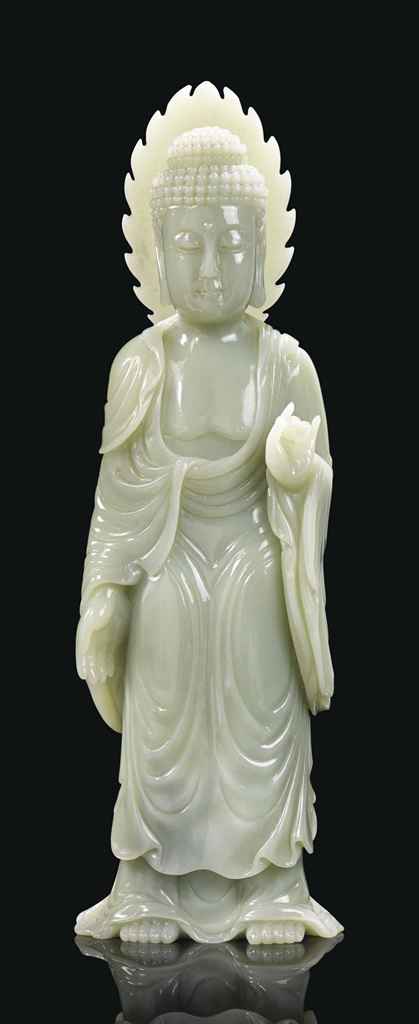
Try LotSearch and its premium features for 7 days - without any costs!
Be notified automatically about new items in upcoming auctions.
Create an alert